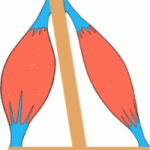
Human movement and function requires a balance of muscle length and strength between opposing muscles surrounding a joint. Normal amounts of opposing force between muscles are necessary to keep the bones centered in the joint during motion; this would be considered ‘muscle balance’. On the other hand, ‘muscle imbalance’ occurs when opposing muscles provide different directions of tension due to tightness and/or weakness. When a muscle it too tight, the joint tends to move in that direction and is limited in the opposite direction since this is typically ‘the path of least resistance.’ For example, the quadriceps and hamstrings of the knee joint perform opposite motions; an imbalance between the two could put undue stress on the joint. A tight hamstring would not allow the joint to glide normally or fully extend, which could put extra stress on the quadriceps muscle and patella (knee cap).
Muscle imbalances can be characterized by either side-to-side (right versus left) or front-to-back (agonist versus antagonist) differences in muscle length or strength. Most musculoskeletal pain syndromes are caused by front-to-back differences, or imbalances of muscles surrounding a joint, rather than side-to-side differences.
There are also 2 recognized causes of muscle imbalance. The first is a bio-mechanical cause from repeated movements in one direction or sustained postures. The bio-mechanical causes of muscle imbalance have been popularized by Kendall and Sahrmann. The second cause is a neuromuscular imbalance due to the predisposition of certain muscle groups to be either tight or weak. The neuromuscular approach was popularized by Janda, and is based on movement patterns that evolve from birth. Dr. Janda noted that the ‘tonic’ group of muscles are prone to tightness and the ‘phasic’ group is prone to weakness.
Recent Posts
- Arthritis?
- 5 Tips for Active Aging
- What is NeuroKinetic Therapy?
- Active Isolated Stretching (AIS) with Aaron Mattes – YouTube
- 50% of Office Workers have Shoulder & Neck Pain
- Forward Head and Rounded Shoulders
- Postural & Muscle Imbalance
- Sway Back, Lumbar Lordosis & Pelvic Tilt
- Benefits of Kinesio Taping
- Active Isolated Stretching for Runners
- The Pain Facts
Keith Caskey
- 8770 Guion Rd., Suite L Indianapolis, IN 46268
- 317.997.7416
- [email protected]
- Google Map
- Contact Form
